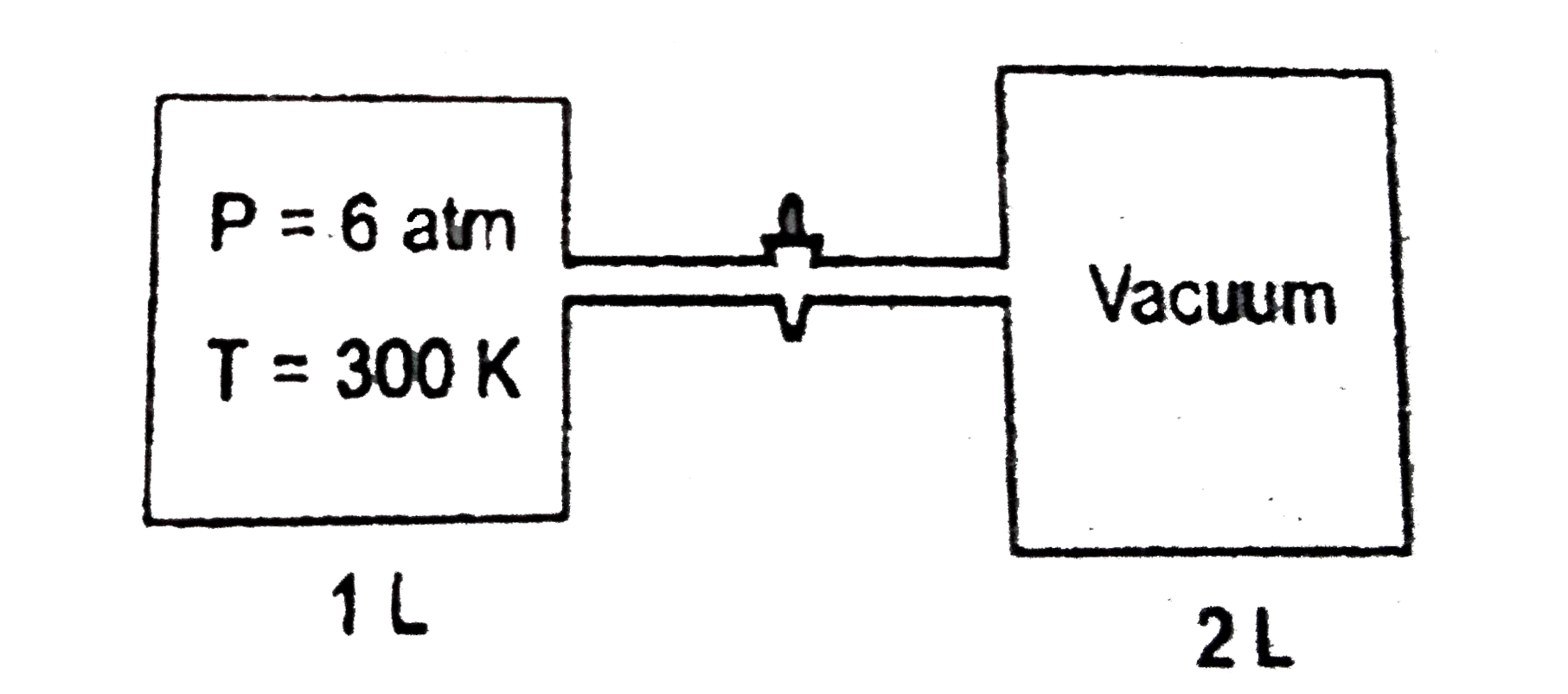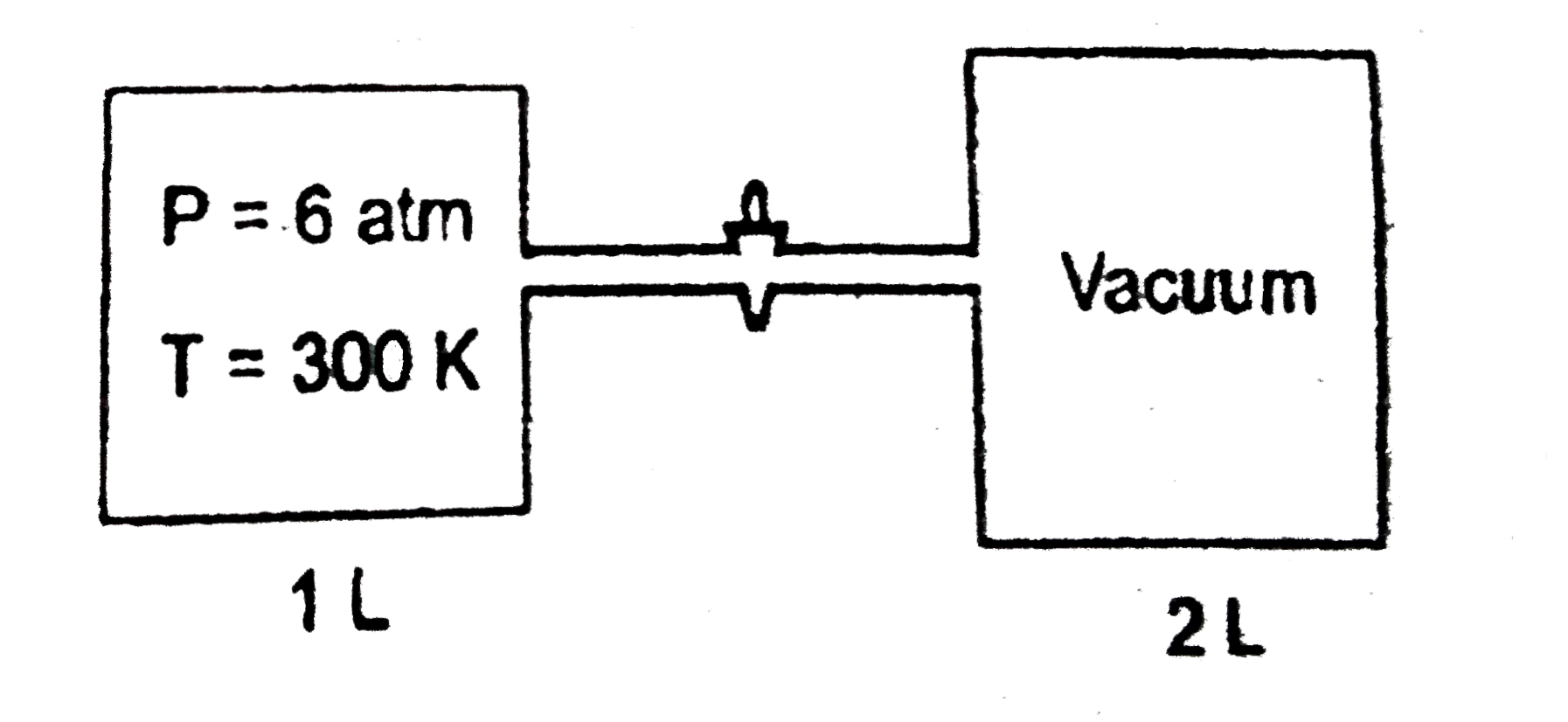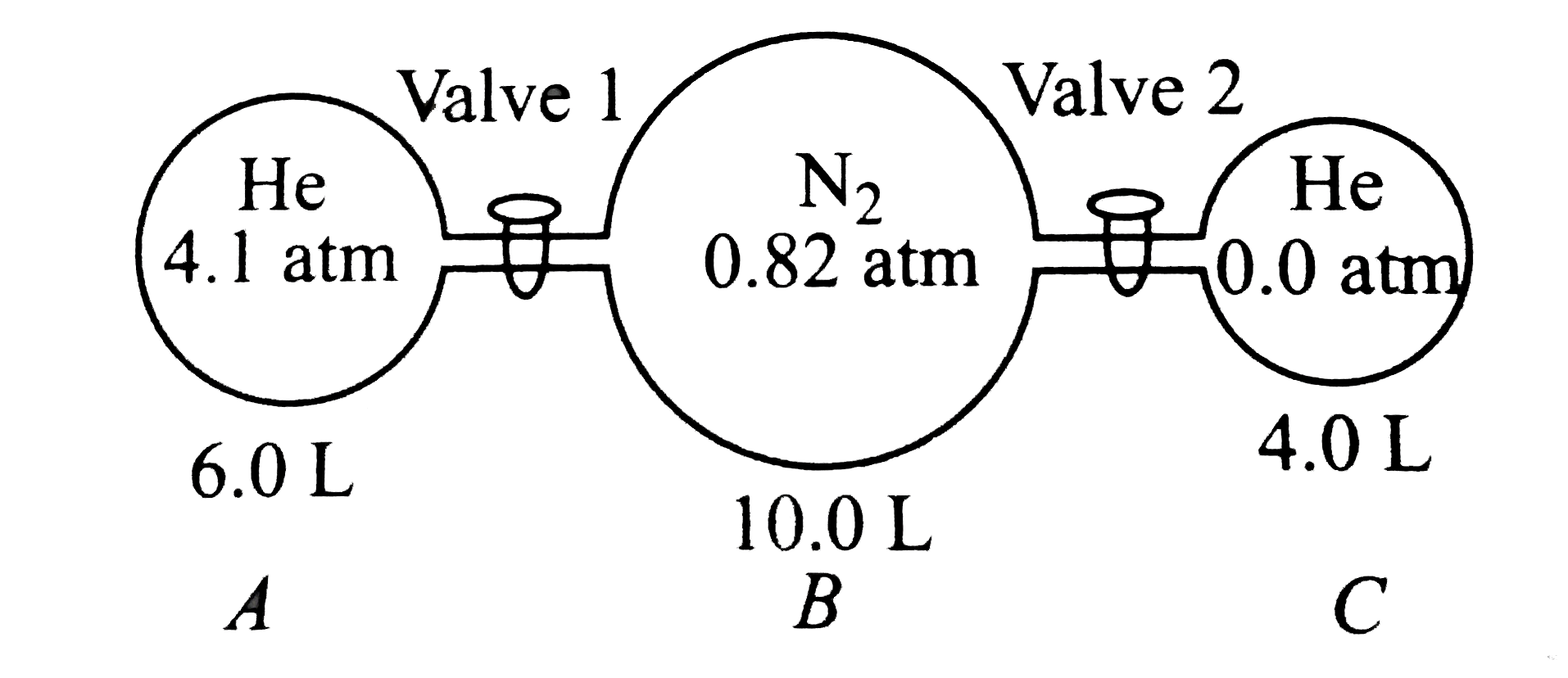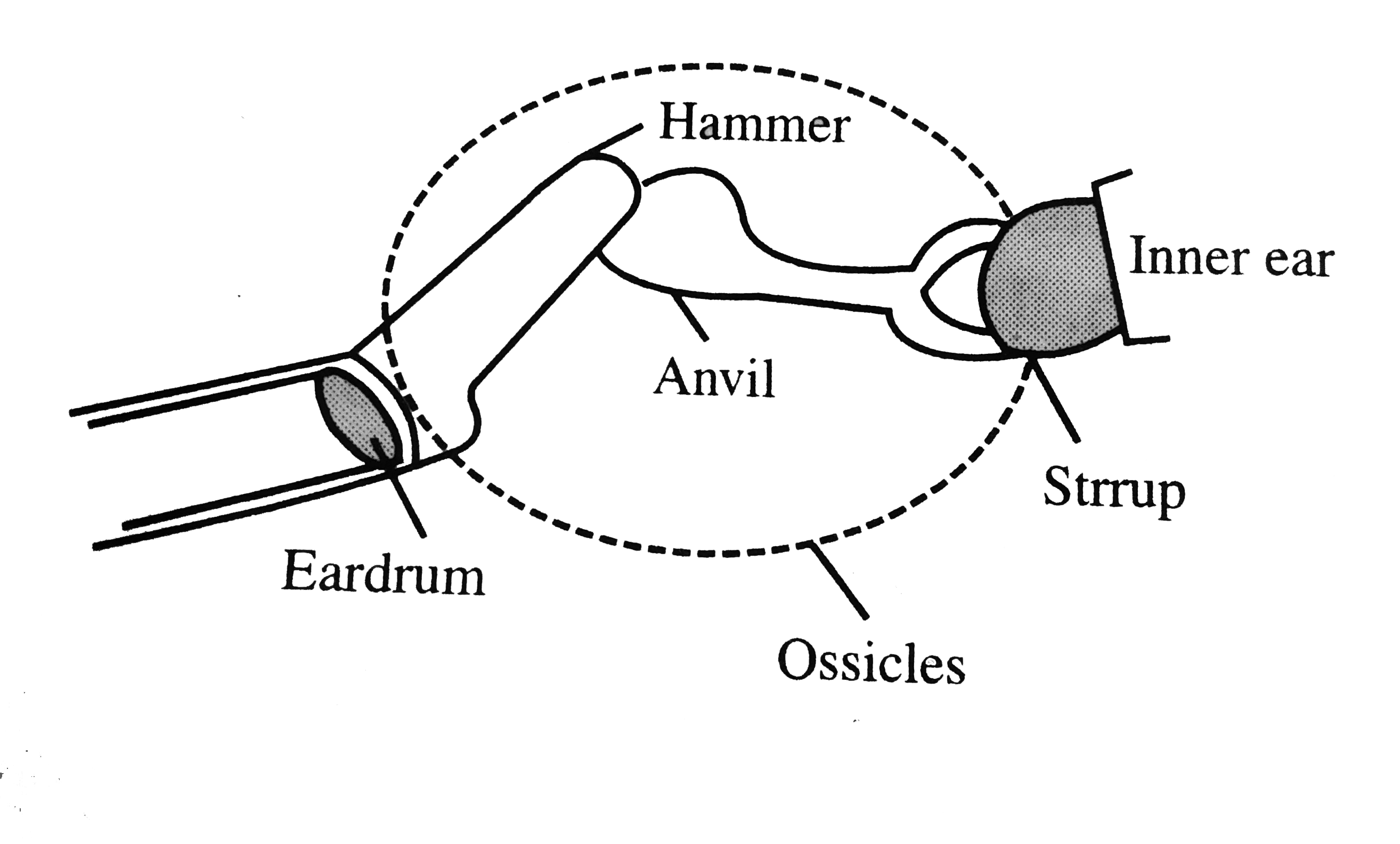It is known fact that gases expand to fill all available volume and their final pressure becomes equal at every point in connected systeam.

If the gas in the above part weigh 15.36g, then select the correct statement(s) :
(R=112l.atm/mol.K)
Options :-
The gas may be SO2
The gas may be CH4
Moles of gas is 625
Moles of gas is 0.96
The correct Answer is:A, C
Π=6cm,Pf=?
Vi=1L,Vf=3L
T=300,T=300K
ni=6×1R×100,nf=ni
⇒Pf=6×1R×300×R×3003=2atm
ni=6112×300=625
⇒MM=15.36625=2.56×25
=64g/mol
So the gas can be SO2
Topper's Solved these Questions
- BOOK - RESONANCE ENGLISHCHAPTER - TEST PAPERSEXERCISE - PART - III CHEMISTRY20videos
TEST PAPERS
- BOOK - RESONANCE ENGLISHCHAPTER - TEST PAPERSEXERCISE - Chemistry701videos
TEST PAPERS
- BOOK - RESONANCE ENGLISHCHAPTER - TEST PAPERSEXERCISE - PART - III CHEMISTRY SEC - 218videos
TEST PAPERS
- BOOK - RESONANCE ENGLISHCHAPTER - SURFACE CHEMISTRYEXERCISE - Section - 51videos
SURFACE CHEMISTRY
- BOOK - RESONANCE ENGLISHCHAPTER - TEST SERIESEXERCISE - CHEMISTRY50videos
TEST SERIES
Similar Questions
It is known fact that gases expand to fill all available volume and their final pressure becomes equal at every point in connected systeam.

in the given arrangement, temperature is maintained constant and the knob is opened. After the gas spreads in the second chamber also, the pressure will be:View SolutionOne mole of an ideal monoatomic gas expands isothermally against constant external pressure of 1 atm from initial volume of 1l to a state where its final pressure becomes equal to external pressure. If initial temperature of gas is 300K then total entropy change of system in the above process is: [R =0.082L atm mol−1K−1=8.3Jmol−1K−1]
View SolutionOne mole of an ideal monoatomic gas expands isothermally against constant external pressure of 1atm from intial volume of 1L to a state where its final pressure becomes equal to external pressure. If initial temperature of gas in 300K then total entropy change of system in the above process is:
[R=0.0082Latmmol−1K−1=8.3Jmol−1K−1]View SolutionThe figure given below shows three glass chambers that are connected by valves of negligible volume. At the outset of an experiment, the valves are closed and the chambers contain the gases as detailed in the diagram. All the chambers are at the temperature of 300K and external pressure of 1.0atm.

Which of the following represents the total kinetic energy of all the gas molecules after both valves are opened?
(R=0.082atmLK−1mol−1=8.314JK_1mol−1)View SolutionThe second law of thermodynamics is a fundamental law of science. In this problem, we consider the thermodynamics of an ideal gas, phase transition, and chemical equilibrium.
Three moles of CO2 gas expands isothermally (in thermal contact with the surroundings, temperature =15.0∘C) against a fixed external pressure of 1.00¯. The initial and final volumes of the gas are 10.0L and 30.0L, respectively.
Select the correct order of the entropy change.View Solution(a) A certain mass of gas initially at (1L,5atm,300K) is expanded reversible and isothermally to final volume of 5L, calculate the work done by the gas and heat supplied in this process to the gas.
(b) Now, if the gas is released to initial position by compressing it using an external constant pressure of 5 atm. Find work done on the gas in this process and heat rejected by gas
(c ) In the above two processes, what is the net gained by surroundings ?
[Note: From above question see that surrounding has done extra work on the system but system has returned that work in the form of heat to surrounding and work is considered on organized form of energy while heat as an unorganised form hence in the above process, there must be net increment in randomness of universe which be called Entropy, soon]View SolutionA solution is prepared by dissolving 1.5g of a monoacidic base into 1.5kg of water at 300K, which showed a depression in freezing point by 0.165∘C. When 0.496g of the same base titrated, after dissolution, required 40mL of semimolar H2SO4 solution. If Kfof water is 1.86Kkgmol−1, then select the correct statements (s) out of the following( assuming molarity = molarity):
View SolutionA closed cylinder contains 40 g of SO3 and 4 g of helium gas at 375 K. If the partial pressure of helium gas is 2.5 atm, then the volume of the container is (R = 0.082 L-atm K−1 mol−1)
View SolutionThe reaction 2AX(g)+2B2(g)→A2(g)+2B2X(g) has been studied kinetically and on the baiss of the rate law following mechanism has been proposed.
I. 2AX⇔A2X2 (fast and reverse)
II. A2X2+B2→A2X+B2X
III. A2X+B2→A2+B2X
where all the reaction intermediates are gases under ordinary condition.
form the above mechanism in which the steps (elementary) differ conisderably in their rates, the rate law is derived uisng the principle that the slowest step is the rate-determining step (RDS) and the rate of any step varies as the Product of the molar concentrations of each reacting speacting species raised to the power equal to their respective stoichiometric coefficients (law of mass action). If a reacting species is solid or pure liquid, its active mass, i.e., molar concentration is taken to be unity, the standard state. In qrder to find out the final rate law of the reaction, the concentration of any intermediate appearing in the rate law of the RDS is substituted in terms of the concentration of the reactant(s) by means of the law of mass action applied on equilibrium step.
Let the equilibrium constant of Step I be 2×10−3mol−1L and the rate constants for the formation of A2X and A2 in Step II and III are 3.0×10−2mol−1L−1min and 1×103mol−1L−1min (all data at 25∘C), then what is the overall rate constant (mol−2L2−1min) of the consumption of B2?View Solution
When a sound wave enters the ear, it sets the eardrum into oscillation, which in turn causes oscillation of 3 tiny bones in the middle ear called ossicles. This oscillation is finally transmitted to the fluid filled in inner portion of the ear termed as inner ear, the motion of the fluid disturbs hair cells within the inner ear which transmit nerve impulses to the brain with the information that a sound is present. The theree bones present in the middle ear are named as hammer, anvil and stirrup. Out of these the stirrup is the smallest one and this only connects the middle ear to inner ear as shown in the figure below. The area of stirrup and its extent of connection with the inner ear limits the sensitivity of the human ear consider a person's ear whose moving part of the eardrum has an area of about 50mm2 and the area of stirrup is about 5mm2. The mass of ossicles is negligible. As a result, force exerted by sound wave in air on eardum and ossicles is same as the force exerted by ossicles on the inner ear. Consider a sound wave having maximum pressure fluctuation of 4×10−2Pa from its normal equilibrium pressure value which is equal to 105Pa. Frequency of sound wave in air is 332ms. Velocity of sound wave in fluid (present in inner ear) is 1500ms. Bulk modulus of air is 1.42×105Pa. Bulk modulus of fluid is 2.18×109Pa.
Q. With respect to information provided above, mark the correct statement.View Solution

